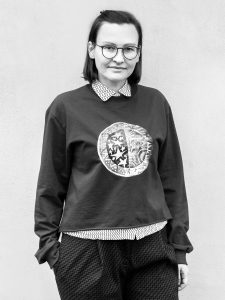Yevheniia Moliar

Kurzvita
- born 1981, Kyiv, Ukraine
- 2022-2023 Predoctoral fellow In the Bibliotheca Hertziana, Max Planck Institute for Art History in Rome, Italy
- 2018-2020 Curator and researcher at Kmytiv Museum of Fine Art named after J. Bukhanchuk
- 2014-2017 Curator of a project about soviet mosaics in the Ukraine, International Foundation “IZOLYATSIA. Platform for cultural initiatives”
- since 2015 Member of the art initiative “DE NE DE”
- 2005-2008 Head of the Department of Research and Education at the National Museum of Ukrainian Decorative Art
- 2007-2013 Master of History and Theory of Art, National Academy of Art and Architecture in Kyiv, Ukraine
Kontakt
Technische Universität Berlin
Fakultät VI – Planen Bauen Umwelt
Institut für Stadt- und Regionalplanung
Fachgebiet Denkmalpflege
DFG-Graduiertenkolleg 2227 „Identität und Erbe“
D-10623 Berlin
Sitz: Ernst-Reuter-Platz 1 | BH-A 339
D-10587 Berlin
moliar[at]tu-berlin.de
Soviet cultural heritage in Ukrainian contemporary art. A study of contemporary artistic practices related to the critical understanding of uncomfortable cultural heritage
The cultural heritage of the Soviet period is an important part of the identity of modern Ukraine. Architecture and art, created in the Ukrainian Soviet Republic during the 70 years, is a valuable and unique cultural part that needs to be studied and preserved.
Ukrainian Soviet cultural heritage has always been a very emotionally sensitive topic for Ukraine. After the beginning of the Russian invasion of Ukraine in 2014, and especially after Russias’ full-scale military invasion in 2022 Ukrainians want to get rid of everything they have in common with Russia. In particular, the Soviet era heritage. Many objects of monumental art and architecture of that time were intentionally destroyed. Despite the fact that these are works by Ukrainian artists and architects and are important historical and cultural artifacts. The Soviet legacy in Ukraine is mostly neglected by the state heritage institutions, who barely deal with objects of the Soviet period. But critical rethinking of Sovietness happens mainly in the field of contemporary art.
The research is based on art projects from 2010-2022 that relate either to Soviet architecture and urban planning, to art in public space and soviet art represented in museums. An important feature of such projects is that they are able to emphasize structural phenomena. This quality is important for working with the understanding of cultural heritage in society. The research provides for the description, analysis and categorization of relevant artistic practices. The issue of preserving the uncomfortable cultural heritage of the totalitarian or colonial past is relevant today for many countries. Contemporary artistic practices can signify new approaches to recognising such heritage. And contribute to its reasonable preservation, instead of destruction.
Publikationen
- 2023 “Ukraine must stop destroying its cultural heritage” The Spectator
https://www.spectator.co.uk/article/ukraine-must-stop-destroying-its-cultural-heritage/ - 2022 “Destruction. About the war with monuments” Your Art https://supportyourart.com/columns/ruj_nacziya/
- 2021 “Experimental and demonstration villages of Ukraine: about the village of Kalita” Your Art https://supportyourart.com/columns/eksperymentalno-pokazovi-sela-ukrayiny-pro-selyshhe-kalyta/
- 2018 “Art is not to blame” Zaborona. https://zaborona.com/mystetstvo-ne-vynne-chomu-varto-zberihaty-khudozhni-tvory-radianskoi-doby/
- 2016 “Soviet monumentalism: subject of decommunisation or urban identity” Mistosite https://mistosite.org.ua/en/articles/radianska-monumentalistyka-predmet-dekomunizatsii-chy-urban-aidentyka